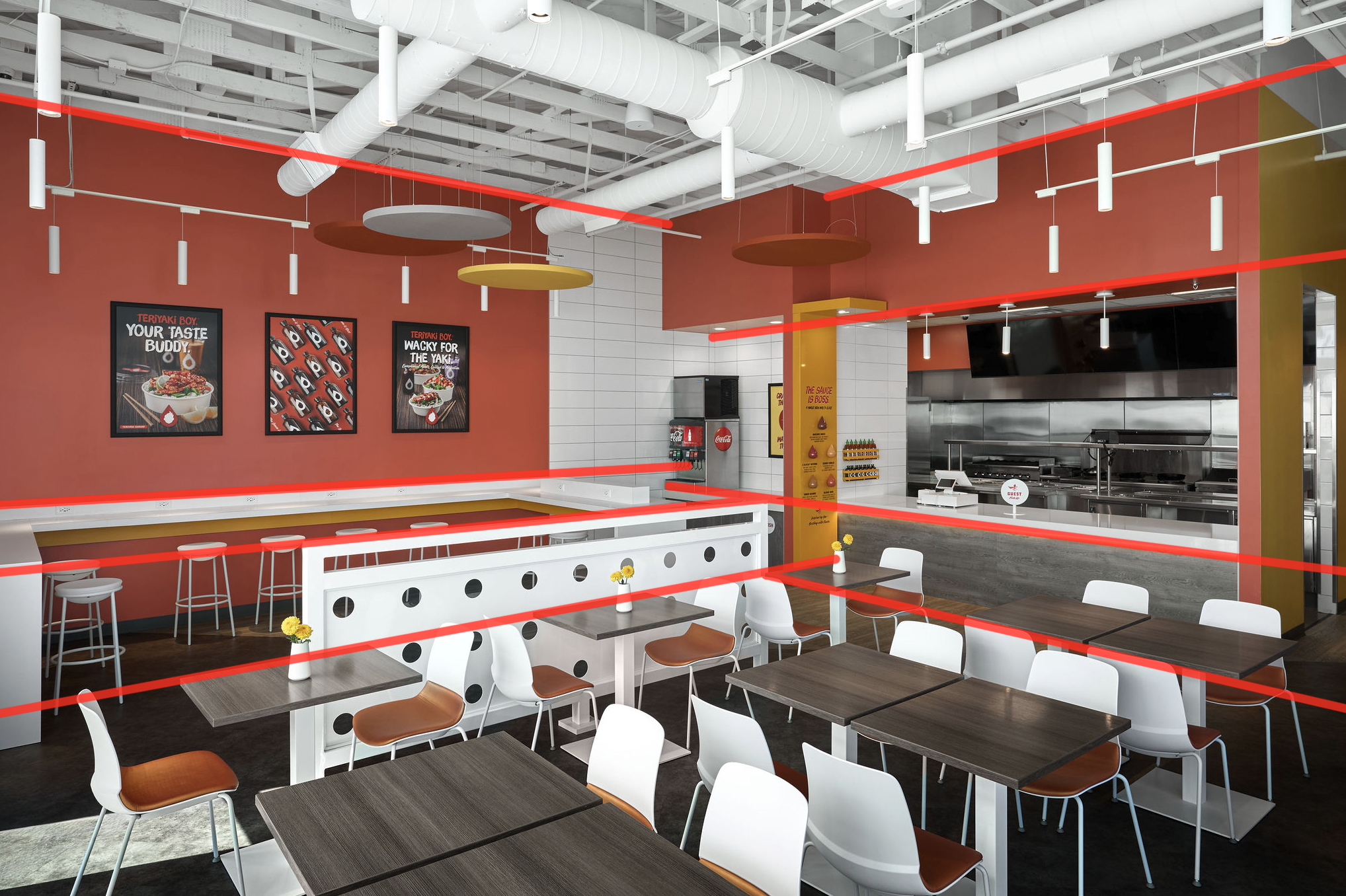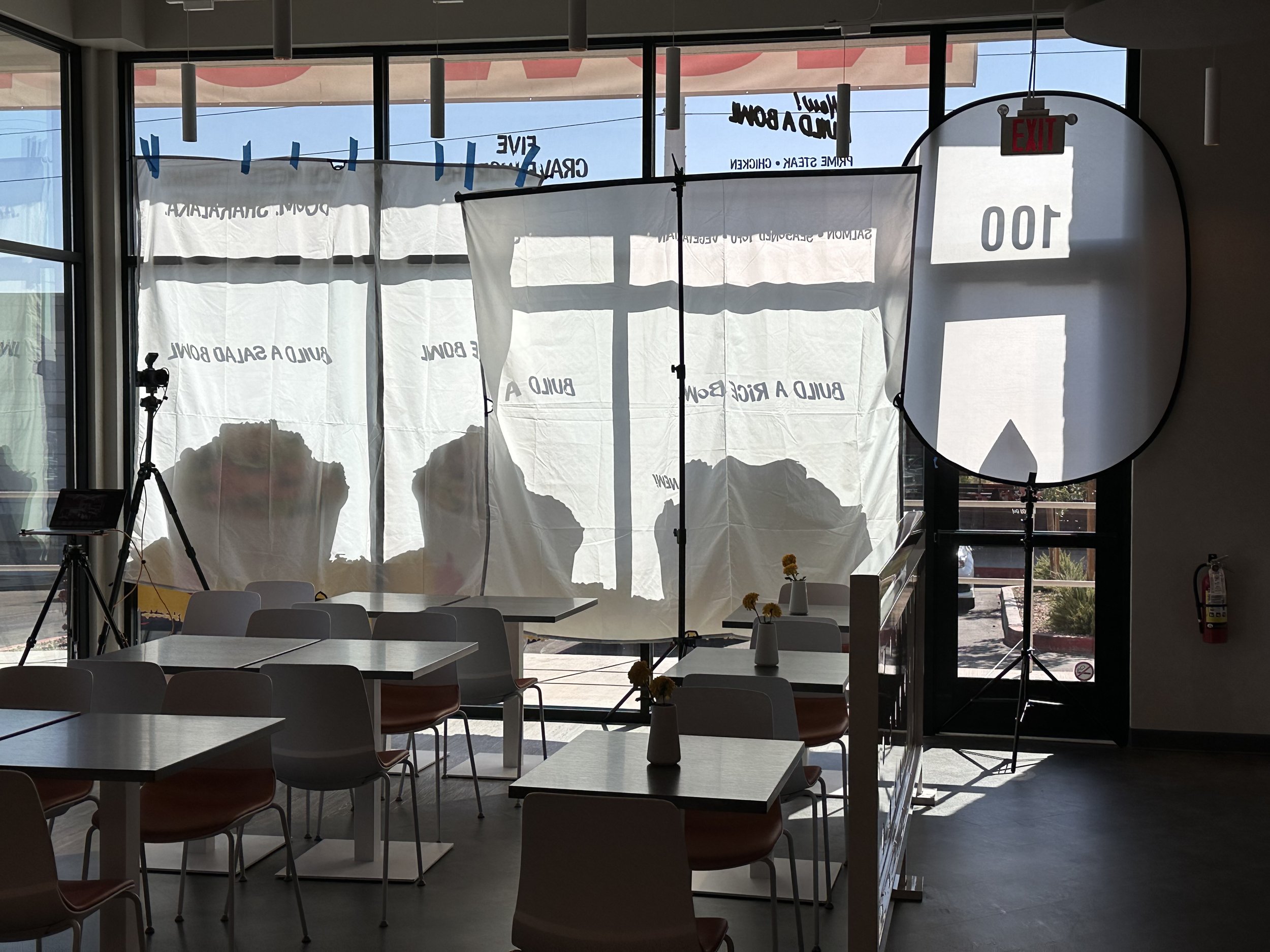A Photographer’s Breakdown of a Restaurant Photoshoot in Las Vegas, Nevada
24mm Canon Tilt-shift lens. Centered on the white wall and shifted left.
As a hospitality and interiors photographer, I love to travel, and an exciting project I recently worked on brought me to the fabulous Las Vegas, Nevada. This project was for the designer and brand manager of Teriyaki Boy, a fast food concept that merges bold, Japanese-inspired flavors with a modern, fast-paced dining experience. The brand's signature colors of red, yellow, and white accents create a dynamic atmosphere that was both challenging and rewarding to capture.
Here’s a behind-the-scenes look at how I approached photographing this space, focusing on its distinct design elements and spatial layout.
32mm Focal length- Tamron 28-75mm
Gear Breakdown and Amazon Links:
Camera: Sony A7RIII
Lenses and adaptors: Tamron 28-75mm, Tamron 17-28mm, Canon 24mm Tilt-shift lens, Sigma Mount Converter MC-11 (Sony to Canon), Canon 1.4 Teleconverter
Lighting Gear:
Westcott Scrim Jim Cine 1-1/4-Stop Diffusion Fabric (8' x 8') x2
Godox 5-in-1 Oval Multi Disc Diffuser x2 (4’ and 6’)
Godox AD200 x2 and AD600 (only used for a few images)
Tripod and stands:
Benro Tripod
Inovativ DigiSystem Lite Kit (Laptop holder)
Post-Processing: MacBook Pro, Capture One, Photoshop, Lumenzia plugin
69mm Focal length- Tamron 28-75mm
Bringing Brand Colors to Life
Prior to the shoot, I made sure to have multiple conversations with the client to fully understand the brand and their needs for the photos. Teriyaki Boy’s color palette was a standout feature of this shoot. The bold red, yellow, and white are used strategically to create a lively atmosphere. In my photos, I emphasized the interplay between these colors.
Highlighting the Layout, Design, and Architectural Details
The interior of Teriyaki Boy is designed to accommodate fast-paced service while maintaining a comfortable, engaging dining experience. The open-plan layout features a mix of bar-style seating areas, group tables, and eye-catching floating yellow ceiling accents that draw the eye upward. Wide-angle shots allowed me to capture the full expanse of the space, while close-up shots highlighted how the colors work together in smaller details like the circular wall tiles and modern furniture.
One technique I often use is lining up one point compositions. The key is making sure all the vertical and horizontal lines in the image are straight. When done correctly, this creates a dynamic and interesting look. However, one downside is that one-point compositions don’t show as much of the space as angled compositions.
For the full dining room images, I used a two-point composition where my vertical lines remain straight, but my horizontal lines converge toward the center of the frame.
Balancing Natural and Artificial Light
Lighting is always critical in interior photography, and this project was no exception. Teriyaki Boy's space is filled with large windows, allowing an abundance of natural light to illuminate the bright colors and clean lines of the space.
For this shoot, I aimed to capture a balanced mix of natural and artificial light in each shot. By photographing the spaces in the morning, I could leverage the beautiful daylight streaming in. In a few images, where the windows were behind the camera and the light was too harsh, I taped up scrims to soften the light.
Typically, I use flash on most of my projects, but with the abundance of natural light, I didn’t find it necessary for most of the images.
Exterior Shots to Complete the Story
No restaurant shoot is complete without capturing the exterior. The modern architecture combined with the vibrant branding gives Teriyaki Boy a strong sense of identity, signaling to customers that they're in for a lively dining experience.
Whenever possible, I like to step back and photograph the exterior from a distance. This helps give the building realistic proportions and avoids wide-angle distortion. For both exterior images, I shot at around 50mm to maintain accuracy.
43mm Focal length- Tamron 28-75mm
55mm Focal length- Tamron 28-75mm
Post-Processing for Maximum Impact
After capturing the vibrant space, post-processing was crucial in bringing out the full energy of Teriyaki Boy’s design. One of my main goals during editing was to make the bold red and yellow colors stand out while ensuring the white accents remained crisp and clean. Using Capture One, I employed AI selection and other tools to target the colors, enhancing saturation for the reds and yellows, while desaturating the whites to give them a sharp, clean look. You could also achieve this look using photoshop by utilizing the color range tool and a saturation layer. Always spend a bit of time refining and double checking your selections
Capture One’s AI selection tool for selective saturation and desaturation.
Photoshops color range tool to select specific area to saturate or desaturate
Another key aspect was managing the natural and artificial lighting. By blending multiple exposures in Photoshop using the Lumenzia plug in. This is to help control area that might be to bright and blow out like windows or bright lights.
Finally, I used various Photoshop tools—like generative fill, the remove tool, and the clone stamp tool—to edit out distracting elements like wall plugs, switches, and vents.
64mm Focal length- Tamron 28-75mm
36mm Focal length- Tamron 28-75mm
Final Thoughts
Photographing Teriyaki Boy in Las Vegas was an exciting project that allowed me to play with bold colors, interesting textures, and modern design elements. As a hospitality, retail, and interiors photographer, it’s always rewarding to work with spaces that have such a clear and vibrant brand identity. The challenge was in finding the right angles to showcase the restaurant’s personality, and I’m proud of how the final images convey the energy and aesthetic of this unique fast food concept.
If you'd like to learn about the basics of interiors photography, check out this article.
Please feel free to leave a comment or question, and I’ll be sure to answer!













